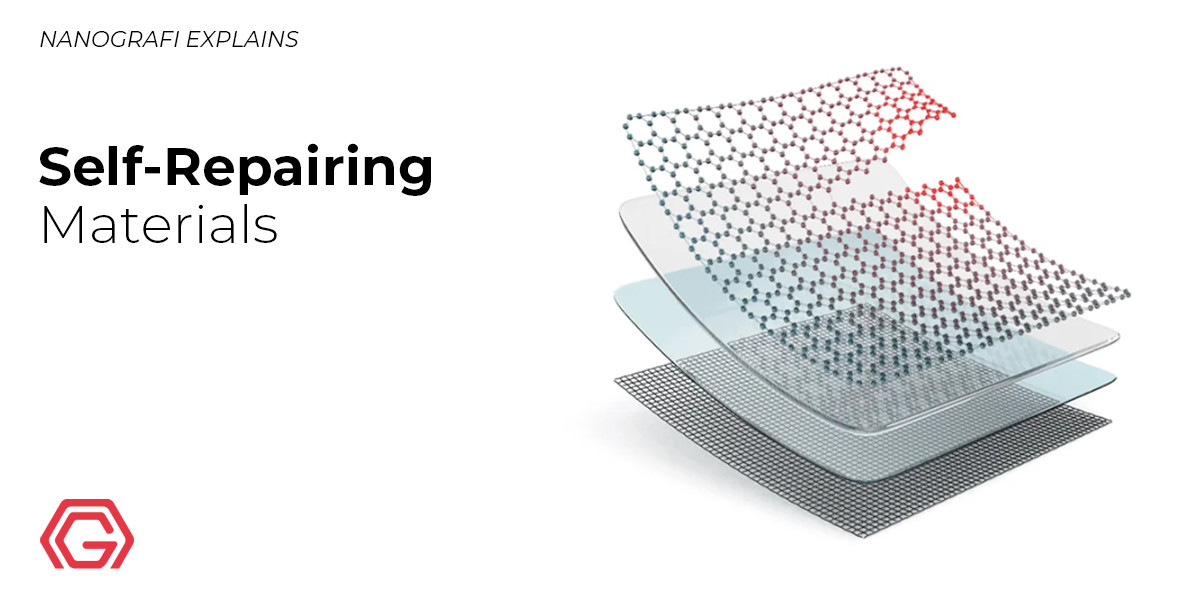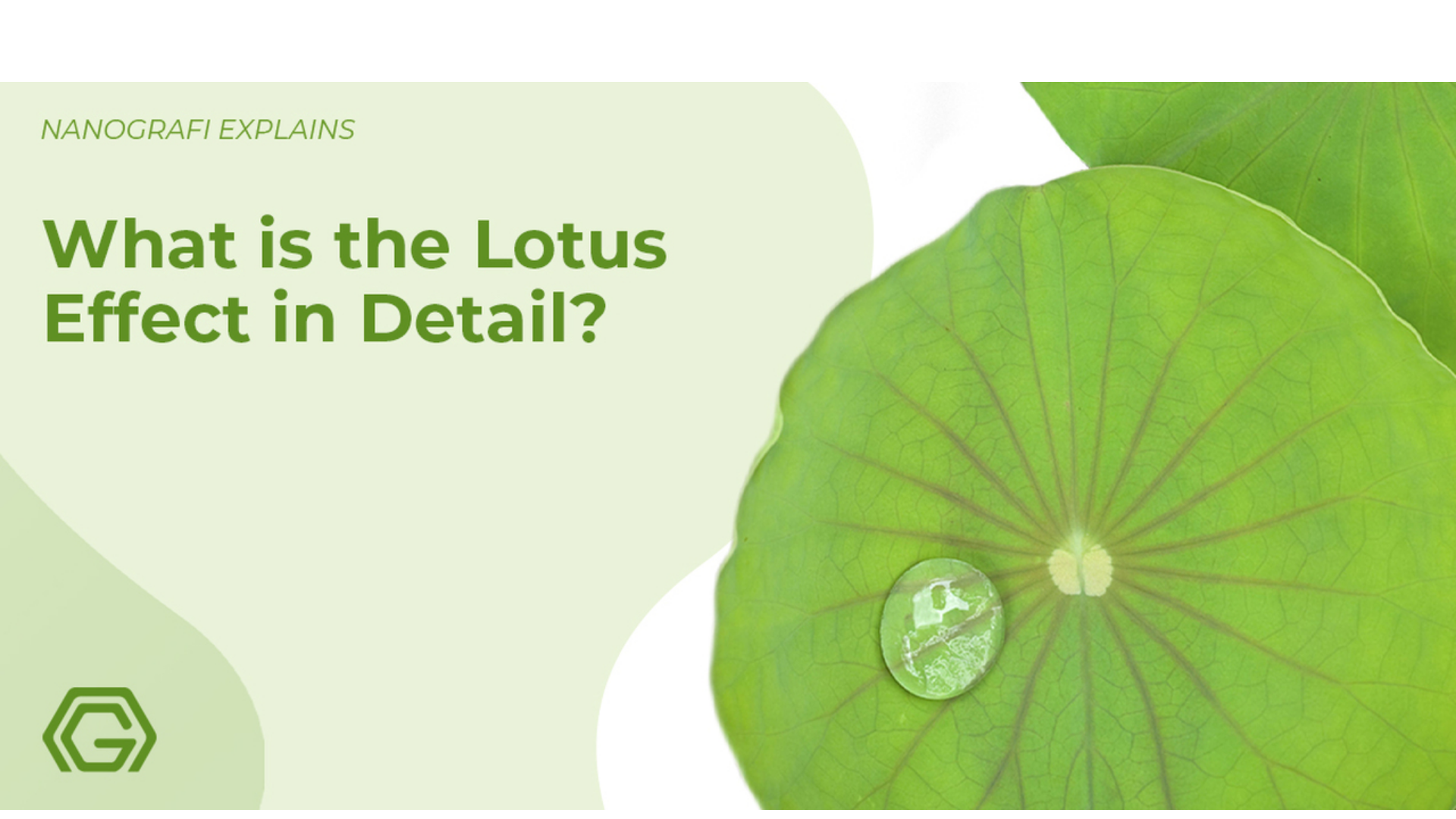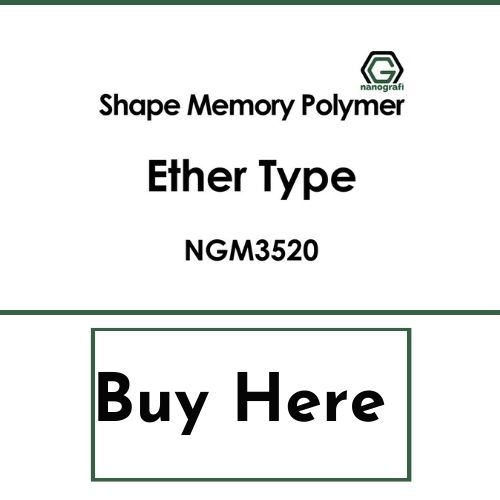Self-Repairing Materials
The development of self-repairing materials is an important improvement in material science. These materials allow the prevention and restoration of damage improving the lifetime and performance of products.
Self-repairing materials are utilized in industrial, medical, and commercial products and applications.
Introduction
The effect of environmental factors and time on materials is inevitable. Most materials lose their integrity, performance, function, and value over time due to damages and degradation. The main causes of damage and degradation are harmful substances such as oxygen, salt, water, active materials, poisons; environmental factors such as heat, light, pressure, mechanical force, and sudden impacts. These continuous effects pile up over time and cause failures that render the materials useless. Over the years, scientists and engineers have strived to avoid or at least delay these detrimental effects. As a result, two different prevention mechanisms have been developed; passive and active response mechanisms. Passive prevention relies on placing protective agents between the material and the damaging effect. The longevity and effectiveness of protection are directly related to the concentration of the agent and this mechanism shows no reparability. Currently, most systems use passive protection mechanisms that have limited lifetime and functionality related to the concentration of protective additives and the rate of consumption. Hence, an enhanced protection mechanism is required which led scientists to active protection mechanisms. Active prevention relies on the self-repair properties of materials. Self-repairing materials have the ability to heal and restore the original properties in the event of damage or degradation. Materials with self-repairing properties are polymers, ceramics, metals, and their composites. Self-repairing materials show better overall performance and longer lifetimes providing economical and environmental benefits to systems. But the question remains; what is self-repairing? Self-repairing is an intrinsic property of nature mimicked to develop and design enhanced materials with the ability to restore to the desired operating state after exposure to damaging factors. Self-repairing is achieved through several different mechanisms developed over the years.
How Does Self-Repairing Work?
Initially, self-repairing systems can be categorized as autonomous and non-autonomous. Autonomous self-repairing does not require any trigger to activate the self-repairing process. On the other hand, non-autonomous systems require a trigger such as UV light, heat, or water to activate self-repairing property. The self-repairing mechanisms can also be separated into two categories based on the self-repairing system; intrinsic and extrinsic self-repairing. Intrinsic self-repairing is based on specific molecular structures that enable the healing of damaged areas. Intrinsic self-repairing is achieved through physical, chemical, or supramolecular interactions. Intrinsic self-healing through physical interactions is often non-autonomous and involves five healing phases; surface rearrangement, surface reproach, wetting, diffusion, and randomization. Thermoplastic materials often show physical intrinsic self-repairing properties. Thermal activation causes thermoplastic to melt into the damaged area, heal through diffusion, and ensure the elimination of cracking interface through randomization. Similar self-repairing behaviour is also observed upon ballistic impact due to the thermal heat of the bullet. Intrinsic healing through chemical interactions involves the recombination of broken molecules hence is limited to smaller-scale defects. However, chemical interactions allow repeated healing and elimination of damages at the early stages. Intrinsic self-repairing through supramolecular interactions is observed in polymeric systems. Supramolecules are defined as molecules with structure specific interaction of high selectivity. Hence, damage to the structure of supramolecules is rapidly repaired through intermolecular non-covalent interactions such as hydrogen bonding, metal ion coordination, halogen bonding, pi-pi interactions, and hydrophobic interactions.
Extrinsic self-repairing requires the inclusion of healing mechanisms in some form of media into the material. The self-repairing properties can be acquired with healing agents or shape memory materials embedded into the structure. One of the most important factors in extrinsic self-repair is the carrier material that stores the healing agent. Hollow glass fibres systems are one of the commonly used carrier systems for self-repairing. In addition to storing healing agents, these glass fibres also enhance the structural integrity of polymers, ceramics, and metals. Mechanical damage to the material causes fracture of the fibres leading to bleeding of the healing agent into the damaged site to initiate the self-repairing process. This method was initially utilized to repair cracks in concrete by including glass fibres filled with healing agents such as cyanoacrylate, ethyl cyanoacrylate, and methyl methacrylate. It was then adjusted to repair polymer systems as well. Three different parameters are important for this type of extrinsic self-repairing applications; the dimensions of the glass fibres, properties of the healing agent, and the concentration of healing fibres within the matrix. Similar to hollow glass fibres systems, hollow carbon fibres are also utilized in self-repairing applications. These systems utilize the excellent mechanical properties of carbon based structures. Another commonly used technique for extrinsic self-repairing systems is utilizing microencapsulated healing agents. These microcapsules can store liquid healing agents or solid healing catalysts within their structure and release these materials upon mechanical damage. It is important to optimize microencapsulated systems considering the type of healing agent and the host material. For example, if the healing agent is liquid than microcapsules should not allow diffusion out of the capsule. At the same time, the microcapsule walls must be resistant enough to processing conditions of the host material, while maintaining excellent adhesion with the host material to ensure that the capsules rupture upon damage. Polymeric microcapsules are one of the most common carrier materials in these systems and are often prepared by the miniemulsion polymerization technique. The mechanical properties and wall thickness of the microcapsule are extremely important for the self-repairing performance. Hence, these properties must be tailored o the specific host materials and applications. Moreover, the size of the microcapsule also plays a role in the performance of the system, in terms of the effect on the toughness of the composite, and the nature of the interface between microcapsule and the host material. Microencapsulation is the first and most studied self-repairing approach from the beginning of research on self-repairing materials and still maintains its importance today.
A novel approach to self-repairing systems is mimicking the most effective self-healing system in nature; microvascular networks. These complex networks are observed in the vascular system, leaf venation, etc. However, creating three-dimensional microchannel systems is a challenging complex task. Today, studies to create such systems focus on soft lithographic methods, laser ablation, and direct writing methods. In contrast to hollow fibres and microencapsulation, these systems provide continuous flowing of the healing agent inside the network and allow self-repairing of the same location repeatedly. Even though different microvascular systems with different materials have been developed utilizing different techniques, this self-repairing approach still requires improvements.
If you are interested in the lotus effect in microparticles,
you can read our blog post here.
Functional Self-Repairing Materials
Self-repairing materials can also show multifunctional properties including electronic/magnetic properties, adhesion, fluorescence, sol-gel transition, pH sensitivity, light sensitivity, and shape memory. These materials improve the functionality of the systems as well as structural integrity.
Self-repairing materials with electronic or magnetic properties come in handy in electronic devices. These materials delay the dysfunction of electrical components whilst improving the conducting properties. For this purpose, self-repairing conducting hydrogels, self-repairing stretchable wires, and single walled carbon nanotubes (SWCNTs) embedded macromolecular polymer structures are utilized. Self-repairing stretchable wires are formed by injecting Liquid metal–eutectic gallium indium into polymeric microchannels. The metallic composite provides excellent electronic properties while the polymeric network provides self-repairing properties. The self-healing conducting materials provide potential substitutes for conventional electronic components with improved structural integrity and lifetime.
Optical responsive self-repairing materials show the formation of new chemical bonds or structural changes in polymer networks upon photo-induced changes. Light-induced self-repairing materials are achieved by incorporating photo-reactive molecules into the polymer structure. Optical effects on these materials cause photo cross-linking reactions that repair the crack damages. Commonly, UV sensitive particles are embedded into self-repairing microcapsules. Another strategy for the development of light-triggered self-healing material is to use a photo-induced metathesis reaction to restore linkages between cracked surfaces. Furthermore, the inclusion of fluorescent particles into the self-repairing materials offers damage detection.
Self-repairing materials with adhesion properties have attracted attention due to their potential biological, medical, and industrial applications. These researches are novel to the self-repairing arena however, they have gained importance rapidly. The adhesive properties are often acquired by using Fe(III) which exhibits underwater attachment to various substrates, adhesive proteins, and non-covalent interactions.
One of the most utilized functional materials in self-repairing systems is shape memory materials. This approach to self-repairing is often utilized in combination with microcapsules and hollow fibres. For example, shape memory alloys are used as functional materials in fatigue crack retardation. Shape memory alloys show large recovery stresses up to 800 MPa due to martensitic phase transformation above their transformation temperature. Shape memory alloy wires contract upon heating and induce a closure force on the cracks inhibiting the growth of damage. This effect assists the self-repairing of the material and reduces the required amount of self-healing agents. Moreover, shape memory polymers are also utilized to provide structural integrity and shape integrity to the self-repairing materials. Shape memory polymers have electrostatic and hydrophobic interactions between the polymeric networks. Electrostatic interactions provide shape memory properties to the network while hydrophobic interactions lead to self-repairing properties.
Incorporating these functional properties and other possible functionalities into self-repairing materials provide multifunctional structures and broaden the application areas of self-repairing materials. It is important to note that these studies are still in their infancy and hold great potential for improvement.
What are The Application Areas of Self-Repairing Materials?
The idea of self-repairing materials has excited several different industries and led to interesting applications. The most intriguing applications of self-repairing materials are self-repairing concrete, medical applications, enhanced solar panel and energy storage applications, improved constructional materials, self-repairing electronic materials, and self-repairing safety equipment such as chemical containers.
Concrete is one of the most commonly used materials in the world and it is notorious for cracking and early deterioration. The damages and cracks in the concrete structure are usually caused by autogenous and drying shrinkages and undesired agglomerations in the concrete structure. Furthermore, the tensile strength of concrete is much lower than its compressive strength. Hence, concrete reinforced with steel shows much more brittle behaviour at the concrete-steel interface. The cracks in the concrete structure allow the permeation of air and rain leading to premature corrosion of steel. Normally, the damages in the concrete structure are monitored and repaired by human efforts. However, these interventions are costly and require too much effort. This is why self-repairing properties have created incredible excitement in the concrete industry. Self-repairing properties are often acquired by including fibre structures such as hollow glass, carbon, polyethylene, steel, or composite fibres. These concrete materials are referred to as fibre reinforced cementitious composites (FRCC). Recently different approaches to self-repairing concrete have focused on self-repairing admixtures such as mineral producing bacteria and geo-materials. Bacteria act as a catalyst for the precipitation of calcium carbonate as filler material for the cracks. However, this approach is limited by the lifetime and sensitive nature of bacteria. Geo-materials such as aluminosilicates and calcium composite materials provide self-repairing properties due to swelling effect and recrystallization. Even though these approaches to self-repairing concrete still need further development and optimization, they have promising potential for sustainability and ease of operation.
If you are interested in the automotive applications of lithium-ion batteries,
you can read our blog post here.
Another application area that heavily exploits self-repairing materials is the biomedical field. Especially self-healing hydrogels composed of self-repairing proteins have attracted attention in novel drug delivery, cell culture, and tissue engineering applications. Self-repairing hydrogels that promote cell attachment can be utilized for the acceleration of wound healing. These materials are also used as bio-ink in 3D printing applications and anti-biofouling agents.
Self-repairing materials can also be used for the development of durable smartphone, computer, or tablet screens. At the moment, the screens of these smart devices are produced from glass or plastics which are prone to cracks and expensive to repair. Self-repairing materials can provide longer device lifetimes if they are used in place of these brittle materials.
Similarly, solar panels also suffer from brittle surfaces that get damaged by environmental factors such as thermal shock, trees, storms, rocks, etc. The damage to solar panels significantly reduces their efficiency and electric production capacity. Protecting solar panels with self-repairing materials or incorporating self-repairing properties to the solar cell structure can improve solar energy applications.
Conducting and magnetic self-repairing materials have the potential to be utilized in electronic structures, energy storage systems, and capacitors. Self-repairing electrodes and electrolytes in lithium-ion batteries (LIBs), lithium-sulfur (Li-S) batteries, and supercapacitors show durability to repeated folding deformations, healing of damaged parts, higher security, better efficiencies, and longer service life. However, creating these systems is not as easy as incorporating a self-repairing material and require meticulous design and optimization stages.
Another application area of self-repairing materials is plastic construction materials and home appliances such as pipes, pipe fittings, curtain wall gaskets, and window frames. These are all produced from brittle plastic materials commonly subjected to harsh outside environments. Pipes and pipe fittings are exposed to water damage, seismic activity, rocks, soil movements, etc causing damages and cracking over time. Hence, self-repairing and shape memory materials are found to be promising solutions that would reduce the cost of replacement and repairs. Curtain wall gaskets and window frames are also subjected to degradation due to UV radiation, air, moisture, and freeze-thaw cycles. They become rubbery over time and lose their functionality requiring high replacement costs. Utilizing self-repairing materials such as hydrogels or polymer composites would remove the need for frequent replacements and result in more sustainable, safer buildings.
Similar to plastic construction materials, mechanical seals used in the industry are prone to damage and cracking. Chemicals, pressure, cyclic mechanical loads, thermal shock, or vibration can cause the failure of these materials. The irreversible damages on mechanical seals cost a high amount of maintenance costs due to the interruption of production and actual repairing costs. Having self-repairing seals will not only help improve the longevity of the application but also reduce time and money spent on maintenance.
Ethylene tetrafluoroethylene (ETFE) is a commonly used plastic material with high corrosion resistance and strength over a wide temperature range. It is used as a sustainable building material as it allows optical control of daylight, in flexible photovoltaic systems to produce an alternate form of energy, and several different systems utilizing its optical properties. However, ETFE is subject to tearing and damage from external elements such as hail, rain, wind, ice, and even birds picking at the material. Incorporating self-repairing materials to these applications in conjunction with ETFE would improve the durability and efficiency of these systems.
Researchers also study on providing self-repairing properties to workshop surfaces and chemical containments. Workshop surfaces are exposed to daily damages from tools and chemicals while the structural integrity of chemical containments holds an important role in workplace safety. Both of these materials are frequently used in harsh working environments and are subjected to cracking. Any failure of chemical containers can cause detrimental effects due to chemicals flammability, reactivity to air or water, corrosive nature, and high toxicity. Thus, utilizing self-repairing materials can provide advantages in terms of safety and quality of the work environment.
Needless to say, self-repairing materials are commonly used in coating technologies. Self-repairing materials are utilized in protective paintings on spacecraft, airplane parts, or automobiles.
Conclusion
Recently, material science has become of the most important fields. Improving the structural properties, lifetime, and functionality of materials hold an important place in the improvement of other technological developments. One of the most challenging problems of material sciences is the detrimental effect of time, cyclic loads, and environmental effects on materials. The repair and replacement costs have become a real burden on industrial applications as well as commercial applications. Scientists have developed two different approaches to this problem; passive and active prevention. Passive prevention involves placing a barrier between the environment and the material. Even though these barriers serve the purpose and protect the material they eventually degrade and lose their functionality. This is why active prevention mechanisms were developed. Active prevention mechanisms rely on self-repairing materials. Self-repairing materials, including metals, polymers, ceramics, or their composites, have the ability to heal and restore the original properties in the event of damage or degradation. These materials show intrinsic or extrinsic self-repairing properties. Intrinsic self-repairing properties utilize physical, chemical, or macromolecular interactions in the structure of the material. On the other hand, extrinsic self-repair properties are incorporated into the material structure through healing agents or catalysts. Self-repairing materials have a wide range of potential applications including self-repairing cement, electronics, electrode, and electrolytes for improved energy storage and supercapacitor applications, self-repairing solar panels, smartphone screens, coatings, chemical containers, etc. These application areas are just some of the prominent cases. There are several different application areas both in the industry and daily life that can benefit from self-repairing materials. It is important to note that self-repairing technologies are still in their infancy and hold great potential for improvement.
To get more information, you can visit Blografi.
References
1.Aïssa, B., Therriault, D., Haddad, E., & Jamroz, W. (2012). Self-healing materials systems: overview of major approaches and recent developed technologies. Advances in Materials Science and Engineering, 2012.
2.Thomas, S., & Surendran, A. (Eds.). (2020). Self-Healing Polymer-Based Systems. Elsevier.
3.PITTAS, P. EXPLORING SELF-REPAIRING MATERIALS AND THEIR APPLICATION TOWARDS SUSTAINABLE DESIGN.
4.Fischer, H. (2010). Self-repairing material systems―a dream or a reality? natural Science, 2(08), 873.
5.Chen, J., Huang, Y., Ma, X., & Lei, Y. (2018). Functional self-healing materials and their potential applications in biomedical engineering. Advanced Composites and Hybrid Materials, 1(1), 94-113.
6.Mihashi, H., & Nishiwaki, T. (2012). Development of engineered self-healing and self-repairing concrete-state-of-the-art report. Journal of Advanced Concrete Technology, 10(5), 170-184.
7.Takeda, K., Tanahashi, M., & Unno, H. (2003). Self-repairing mechanism of plastics. Science and Technology of Advanced Materials, 4(5), 435.
8.Cheng, Y., Xiao, X., Pan, K., & Pang, H. (2020). Development and application of self-healing materials in smart batteries and supercapacitors. Chemical Engineering Journal, 380, 122565.
Recent Posts
-
What is the Difference Between 7075 and 6061 Aluminum Alloy?
When comparing 7075 aluminum alloy to 6061 aluminum alloy, it's essential to understand their disti …5th Apr 2024 -
Iron-Air Batteries: The Ultimate Guide
Iron-air batteries represent a significant breakthrough in energy storage technology, offering a sus …29th Mar 2024 -
Discovering the Power of 2D Materials
In material science, the discovery of two-dimensional (2D) materials represents a transformative de …22nd Mar 2024








